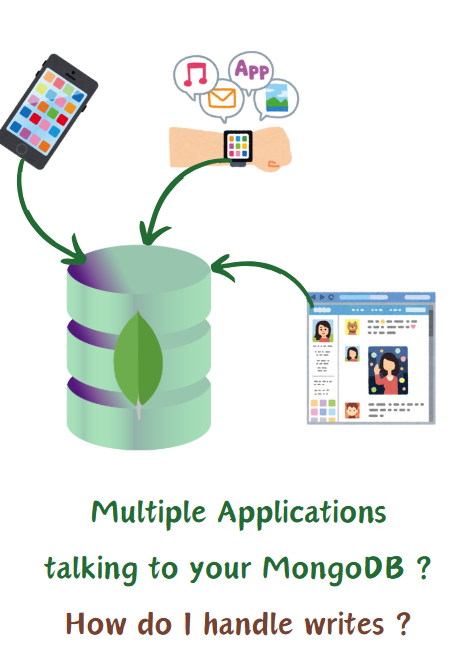“MongoDB Concurrency: Ensuring Data Integrity in Multi-Application Environments”
When two or more applications are interacting with the same MongoDB database and performing updates, concurrency control is critical to ensure data integrity and consistency. Below are the key strategies to handle updates effectively:
Concurrency Challenges in MongoDB
- Race Conditions: Multiple applications or threads may attempt to update the same document simultaneously, leading to inconsistent results.
- Lost Updates: One update may overwrite another if no concurrency control mechanism is in place.
- Dirty Reads: Reading uncommitted data from another transaction can lead to incorrect results.
- Non-Atomic Operations: Without atomicity, partial updates can leave the database in an inconsistent state.
MongoDB Concurrency Mechanisms
MongoDB provides several built-in mechanisms to handle concurrency:
Document-Level Locking
- MongoDB uses document-level locking (since MongoDB 3.0) to ensure that only one write operation can modify a single document at a time.
- This allows concurrent operations on different documents within the same collection
1. Use Atomic Operations
- MongoDB provides atomic updates at the document level. If both applications update different fields in the same document, MongoDB ensures that each update is atomic.
- Use operators like
$set,$inc,$push,$pull, etc., to update only specific fields instead of replacing the entire document.
db.users.updateOne(
{ _id: ObjectId("12345") },
{ $set: { status: "active" } }
);
2. Optimistic Concurrency Control (OCC) with Versioning
- If both applications may update the same document, optimistic concurrency control ensures data consistency.
- Store a version number in the document, and update only if the version matches:
db.orders.updateOne(
{ _id: ObjectId("12345"), version: 2 },
{ $set: { status: "shipped" }, $inc: { version: 1 } }
);
- If the version doesn’t match, the update fails, and the application must fetch the latest data before retrying.
3. Pessimistic Locking (Less Common in MongoDB)
- Pessimistic locking is usually avoided in MongoDB, but you can implement it by introducing a lock flag in documents.
- Application 1 marks the document as “locked,” does processing, and then unlocks it.
db.orders.updateOne(
{ _id: ObjectId("12345"), lock: false },
{ $set: { lock: true } }
);
- Other applications can only update when
lock: false.
4. Transactions for Multi-Document Updates (For Replica Sets & Sharded Clusters)
- If updates span multiple documents, MongoDB transactions (introduced in v4.0) ensure atomicity.
with client.start_session() as session:
with session.start_transaction():
db.users.update_one({"_id": 1}, {"$set": {"status": "active"}}, session=session)
db.orders.update_one({"_id": 100}, {"$set": {"shipped": True}}, session=session)
session.commit_transaction()
- Transactions ensure that both updates succeed or fail together.
5. Change Streams for Real-Time Updates
- If both applications need to be aware of changes, Change Streams can notify them of updates in real-time.
pipeline = [{'$match': {'operationType': 'update'}}]
with db.orders.watch(pipeline) as stream: for change in stream:
print("Order updated:", change)
6. Conflict Resolution Strategies
- Last write wins (LWW): Accept the latest update based on a timestamp.
- First write wins (FWW): Ignore later updates if a field is already modified.
- Merge fields: Combine both updates using application logic.
7. Retry Logic
- Implement retry logic for transient errors or conflicts.
- Example: Retry a failed update operation after a short delay.
Choosing the Right Strategy
- If updates are independent, atomic operations (
$set,$inc) are sufficient. - If updates may conflict, optimistic concurrency control or transactions is better.
- If updates should be sequential, consider locking (though not ideal in MongoDB).
- If both applications need real-time awareness, use Change Streams.
Best Practices for Concurrency Control
- Minimize Contention: Design your schema to reduce contention on frequently updated documents.
- Use Sharding: Distribute data across shards to reduce contention and improve scalability.
- Monitor Performance: Use MongoDB’s profiling and monitoring tools to identify and address concurrency bottlenecks.
- Test for Concurrency: Simulate concurrent workloads to test your application’s behavior under high concurrency.
Tools and Features for Concurrency Management
- MongoDB Atlas: Provides built-in monitoring and alerting for concurrency issues.
- MongoDB Ops Manager: Helps manage and optimize database performance.
- MongoDB Compass: Visualize and analyze query performance and locking behavior.
Example Scenario
Imagine an e-commerce application where multiple users can purchase the same item. To handle concurrency:
- Use an atomic operator (
$inc) to decrement the item’s stock. - Implement optimistic locking to handle simultaneous updates.
- Use transactions if multiple documents (e.g., inventory and orders) need to be updated atomically.
Common Pitfalls
- Overusing Transactions: Transactions can introduce performance overhead. Use them only when necessary.
- Ignoring Indexes: Poorly indexed queries can lead to long-running operations and increased contention.
- Not Handling Retries: Failing to implement retry logic can result in lost updates or errors.
Would you like an example based on your specific use case?


Comments are closed, but trackbacks and pingbacks are open.